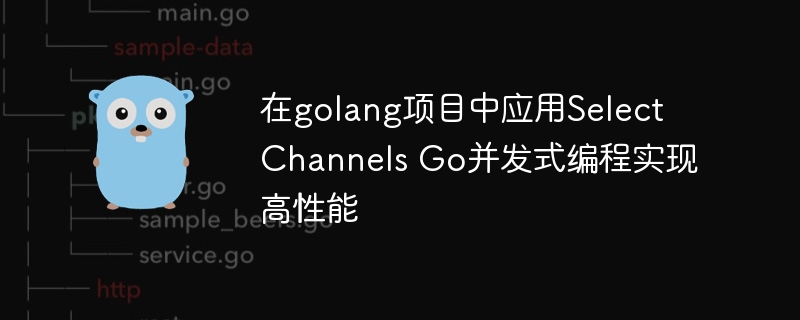

Application of Select Channels Go concurrent programming in golang project to achieve high performance
Introduction:
In today's Internet era, high-performance applications are our pursuit one of the goals. During the development process, using concurrent programming is one of the common means to improve application performance. In golang, high-performance concurrent programming can be achieved using select statements and channels. This article will introduce how to apply select statements and channels in golang projects to achieve high-performance concurrent programming, and give specific code examples.
1. Overview of Concurrent Programming
Concurrent programming refers to a programming method that uses multi-core or multi-tasking of a computer system to handle multiple concurrent tasks. Compared with traditional serial programming, concurrent programming can significantly improve the system's processing power and response speed.
In golang, concurrent programming can be achieved through goroutine and channel. Goroutine is a lightweight thread that can execute concurrently with other goroutines. The channel is the communication mechanism between goroutines and can be used to transfer data between goroutines.
2. Use of select statement
The select statement can wait for data to arrive between multiple channels and return the first prepared channel. It is similar to the switch statement, but each case of select is A communication operation.
The following is a simple example that implements communication between two goroutines through the select statement:
package main import ( "fmt" "time" ) func main() { c1 := make(chan string) c2 := make(chan string) go func() { time.Sleep(time.Second * 1) c1 <- "one" }() go func() { time.Sleep(time.Second * 2) c2 <- "two" }() for i := 0; i < 2; i++ { select { case msg1 := <-c1: fmt.Println("received", msg1) case msg2 := <-c2: fmt.Println("received", msg2) } } }
In the above example, we created two channels for transmitting messages. . Two goroutines send messages to these two channels respectively. Through the select statement, we can wait for the messages to arrive and process them separately. Running the above code, the output result is:
received one received two
3. Use of channels
Channel is the communication mechanism between goroutines and can be used to transfer data between goroutines. In golang, create a channel through the make function, and you can specify the type of data to be transferred.
The following is an example of implementing the producer and consumer model through channels:
package main import ( "fmt" "time" ) func producer(c chan<- int) { for i := 0; i < 5; i++ { c <- i fmt.Println("producer sends", i) time.Sleep(time.Second) } close(c) } func consumer(c <-chan int) { for num := range c { fmt.Println("consumer receives", num) time.Sleep(time.Second * 2) } } func main() { c := make(chan int) go producer(c) go consumer(c) time.Sleep(time.Second * 10) }
In the above example, we created a channel for the producer to send data and the consumer to receive data. . The producer sends data to the channel through a loop, and the consumer receives data through the range loop. By using channels and goroutines, the function of concurrent execution of producers and consumers is realized.
4. Application Example: Implementing high-performance concurrent processing of HTTP requests
In actual development, we often encounter scenarios where multiple HTTP requests need to be processed at the same time. Using concurrent programming can significantly improve the system's processing power and response speed.
The following is an example of code that uses select and channels to implement high-performance concurrent processing of HTTP requests:
package main import ( "fmt" "net/http" "time" ) func request(url string, c chan<- string) { resp, err := http.Get(url) if err != nil { c <- fmt.Sprintf("Error: %s", err.Error()) return } defer resp.Body.Close() c <- fmt.Sprintf("Response from %s: %s", url, resp.Status) } func main() { urls := []string{ "https://www.google.com", "https://www.baidu.com", "https://www.github.com", } c := make(chan string) for _, url := range urls { go request(url, c) } timeout := time.After(time.Second * 5) for i := 0; i < len(urls); i++ { select { case res := <-c: fmt.Println(res) case <-timeout: fmt.Println("Timeout") return } } }
In the above example, we created a slice containing multiple URLs. Then multiple goroutines are started through a loop, each goroutine requests the URL through the http.Get function and sends the result to the main function through the channel. Process the response of each goroutine through the select statement. During Timeout, the program will output "Timeout".
Summary:
Applying select statements and channels in golang projects can achieve high-performance concurrent programming. By communicating and waiting between multiple goroutines, the system's processing power and response speed can be improved. Using concurrent programming can better utilize the multi-core or multi-tasking of the computer system and improve the performance of the application. Through the introduction and sample code of this article, I believe readers have a deeper understanding of how to apply select statements and channels in golang projects to achieve high-performance concurrent programming. I hope readers can make full use of concurrent programming in actual development and improve the performance of their own applications.
The above is the detailed content of Apply Select Channels Go concurrent programming in golang projects to achieve high performance. For more information, please follow other related articles on the PHP Chinese website!




